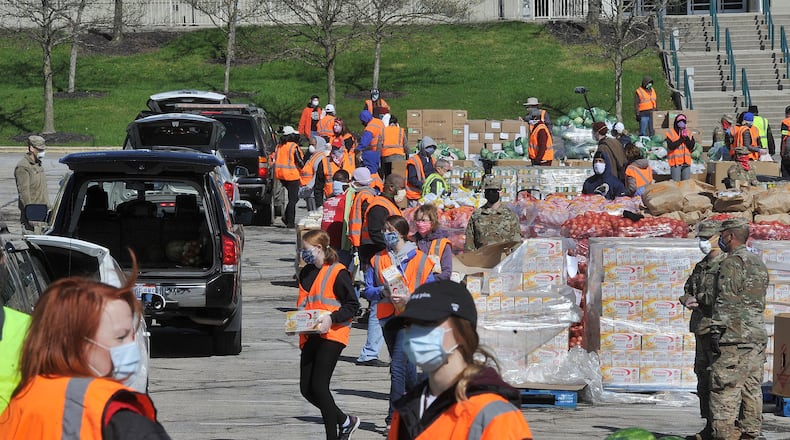Food stamp rolls are expected to grow because more than 92,000 Ohioans have applied for benefits since mid-March following widespread job losses, business closures and wage and shift reductions.
But some hunger relief organizations and policy groups say they believe many people who may be eligible for benefits aren't currently applying, and they say the program should be expanded to better help people in need.
Coronavirus: Complete Coverage by the Dayton Daily News
About “946,566 more Ohioans have joined the unemployment line in the last five weeks and are in desperate need of food,” said Lisa Hamler-Fugitt, executive director of the Ohio Association of Foodbanks. “Everyone of these Ohioans should be enrolling in the SNAP programs so they can be standing in grocery store check out lines and not in longer lines at foodbanks, food pantries and soup kitchens.”
During this crisis, the state has enhanced the program by increasing benefits for some households, extending eligibility deadlines and providing special disaster food aid.
Applications for food stamp benefits increased three out of the four weeks between mid-March and mid-April, according to Ohio Department of Job and Family Services data obtained by this newspaper.
In the week ending April 11, about 29,334 new Ohioans applied for food stamp benefits, which was 172% more than the comparable period in 2019, state data show.
MORE: Stimulus payment problems in Dayton region: too much, too little, few answers
There were 19,300 new applications in the week ending March 21, which was up 76% from the previous week.
The state received 19,065 new applications in the last full week of March, and 24,633 applications the following week.
Before the COVID-19 public health crisis, more than 1.3 million Ohioans received food stamp benefits each month, including about 150,000 people in Butler, Champaign, Clark, Greene, Miami, Montgomery and Warren counties, state data show.
But nearly 1 million Ohioans have been pushed out of work in the last five weeks, according to initial jobless claim data released Thursday, and experts say the true number of losses likely is significantly higher than that.
The community's food needs are not being met, which is evident by long lines at food pantries and the fact that a large number of people seeking food have been turned away at recent distribution event because time and supplies ran out, said Lisa Stempler, president and CEO of the Miami Valley Community Action Partnership, which helps low-income families in the Dayton area.
SNAP can help keep families afloat, especially when there are kids in the house, Stempler said, but some low-income residents have reported having a hard time understanding and navigating the application process.
Stempler also said she’s surprised new applications haven’t seen larger increases, considering the massive job losses.
She said some Ohioans who have been financially harmed by the COVID-19 economic slowdown may not be aware they could now qualify for food assistance.
MORE: Stimulus: When will paper checks be mailed to Ohioans?
Unfortunately, advocates say, food stamp benefits aren't nearly enough to cover needy Ohioans' food bills, considering the average monthly distribution was $126 in January.
“SNAP has always been a lifeline for many of our customers prior to this crisis but has never been sufficient to meet the food needs of a family,” Stempler said.
SNAP is a supplemental food program that provides about $1.40 per meal per person, and the maximum program benefits through out this national health emergency are $194 a month for a single person or $646 for a family of four, said Hamler-Fugitt, with the Ohio Association of Foodbanks.
Hamler-Fugitt said she wishes Ohio right now would auto enroll residents who lost their jobs into the food assistance program when they sign up for unemployment compensation.
“We need to do a much better job educating these unemployed Ohioans about the SNAP program,” she said. “All foodbanks are outreaching to SNAP program, operating call centers and passing out flyers about the benefits of the SNAP program and how people can apply.”
Food stamps are supposed to be the first line of defense against hunger — not foodbanks, which are seeing unprecedented demand with increases of between 100 to 250%, she said.
Earlier this month, Job and Family Services announced it would increase monthly food stamp payments up to the maximum allowable amount for households.
Ohio also obtained approval to extend by six months SNAP recipients’ re-certification eligibility periods for March, April, and May by moving them to September, October and November, said Bret Crow, communications director for the Ohio Department of Job and Family Services.
Ohio obtained federal approval to waive administrative verifications normally required at food banks, to streamline the process and limit person-to-person contact, Crow said.
“That means all program-eligible households can to pick up a prepackaged box of food at their local foodbank,” he said.
RELATED: What's the biggest thing businesses need right now to survive? Cash
Ohio households may be eligible for food stamp benefits if their incomes are at or under 130% of the federal poverty guideline.
The state should should ask the federal government to grant additional months of emergency SNAP benefits to continue providing maximum payments in May and June, said Will Petrik, budget researcher with the liberal-leaning Policy Matters Ohio.
The state also should create a special pandemic food aid program, which Congress authorized, to get resources to children who were receiving free- and reduced-price meals at school, Petrik said.
Important steps the state has taken include suspending work and training requirements and relaxing verification requirements for new applications, according to the Center for Community Solutions in Cleveland.
Policy Matters Ohio and the Center for Community Solutions both support raising food stamp eligibility to 200% of the federal poverty line to help more Ohioans.
About the Author

